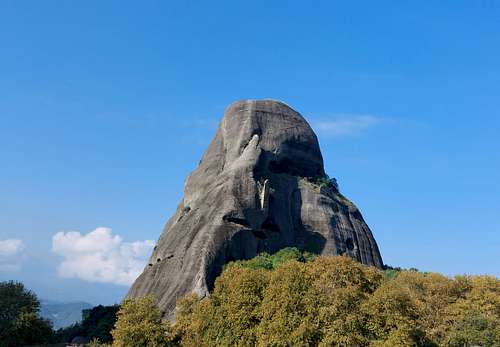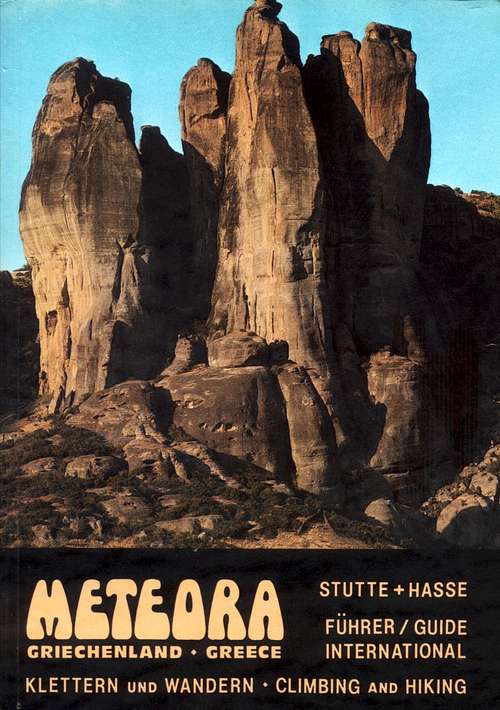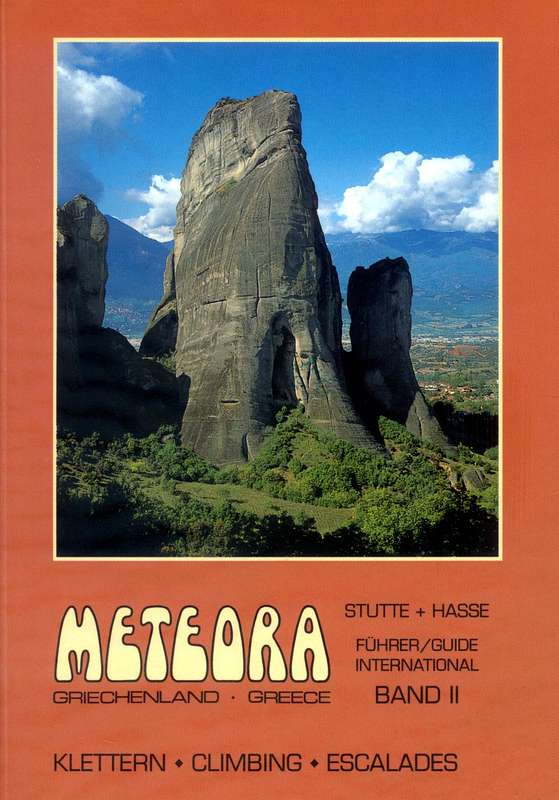-
 12986 Hits
12986 Hits
-
 81.84% Score
81.84% Score
-
 14 Votes
14 Votes
|
|
Mountain/Rock |
|---|---|
|
|
39.72184°N / 21.61848°E |
|
|
Thessaly |
|
|
Trad Climbing |
|
|
Spring, Fall |
|
|
1476 ft / 450 m |
|
|
Overview
Doupianifels/Doupiani Rock
Isolated but very easy to reach, the Doupianifels - Doupiani Rock in English - is for sure one of the most attended rock climbing destination in the Meteora (Μετέωρα) area. The name Meteora, meaning "hanging in the air", refers to an intriguing area located in the Thessaly region of Greece, particularly known for the presence of various ancient monasteries and numerous charming and suggestive climbing routes. Meteora includes about 170 conglomerate summits of various shapes and types, as massive rocky mountains, pinnacles, towers, minor peaks and spires, some of which are truly amazing and bizarre. The range overlooks the village of Kastràki and the town of Kalabàka and features about 850 multi-pitch and single pitch routes. Due to their singularity and a bit of mistery surrounding the place, in addition to the presence of the monasteries, the towers of Meteora are quite famous all over the world.
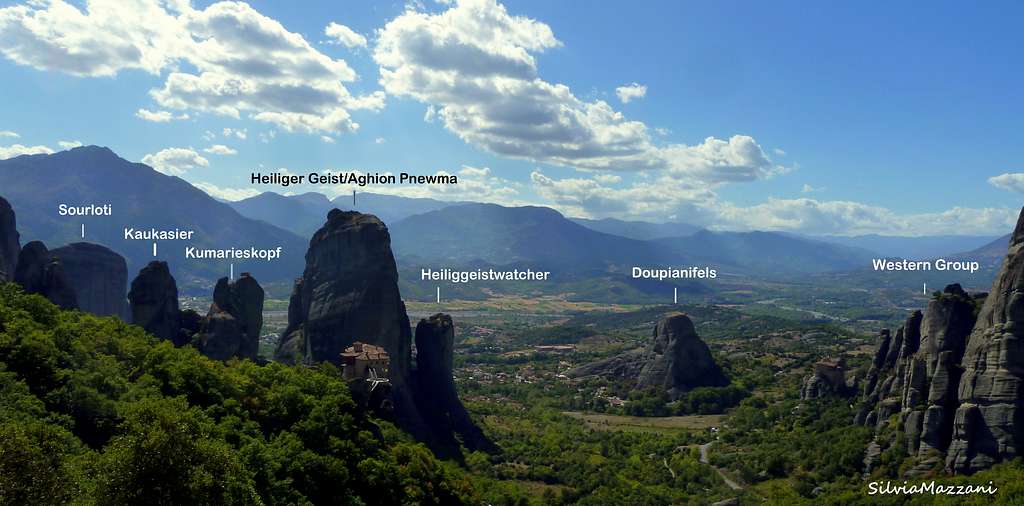
The Doupianifels is a mighty and attractive dome belonging to Meteora Western Group and located just nearby the village of Kastraki, on the left of the main route connecting Kastraki to the monasteries. This location makes Doupiani a venues very easy to identify. For this reason and its fast approach Doupiani is maybe the most frequently climbed summit in Meteora and usually well suited as a reference point.

A bit of Meteora climbing history
All the towers and spires situated in the Meteora area, even the smallest, have a summit book and usually have two names: the local name in Greek and the German name. This latter custom originates from the fact that the climb in Meteora had developed thanks to the enormous activities performed by a group of Eastern Germany pioneers, in primis the physicist Dietrich Hasse and the photographer Heinz Lothar Stutte. Dietrich Hasse is a famous German climber with a lot of first ascents worldwide. The most well-known is Hasse-Brandler on Cima Grande di Lavaredo, Dolomites. Affected by a fascinating picture of Meteora, since the Seventies they began to explore this mountain range and climbed all the most important summits, with the exception of the five towers home of monasteries. The same climbers realized two climbing guide-books of the area. Hasse together with other German climbers is responsible for the development of Meteora. That's why in all the classic routes the ethics are so strict: poor protection on easy face climbing, minimal or no bolt protection on cracks and chimneys, always ground up first ascents etc.
Getting There
Meteora is situated in the Thessaly region of Greece, Northern half of Greece, approximately 25 km NNW from Trikala, and immediately North of Kalambaka and Kastraki, the two main towns in the area, both located very close to the rocks. The closest main town is Larissa. The distance to Kalambaka is about 360 km from Athens and 237 km. from Thessaloníki.

By plane - Meteora can be approached from Athens Eleftherios Venizelos airport or from Thessaloniki airport. From these airports you can:
- take a domestic flight to Larissa (about 85 km from Kalambaka)
- rent a car, useful once you are in Kastraki, but not essential
- use public transports (bus or train). Getting to Meteora without a car is easy thanks to the train from Athens that stops in Kalambaka.
By ferry from Italy – If you wish to travel with your own car, there are different shipping companies and many ferries departures to Igoumenitza from the harbours of Ancona, Bari and Brindisi.
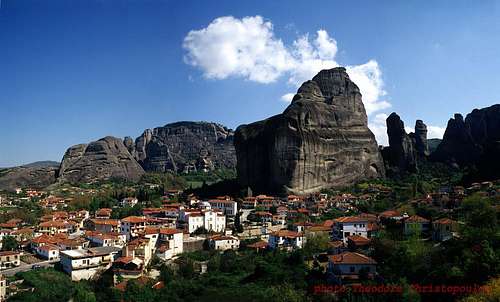
Approach to Doupianifels
The approach is brief and easy. Getting to the Doupiani Rock from the square of Kastraki village is a 10 minutes walk. Actually Doupiani Rock is on the limits of Kastraki illage. Also you can drive with your car to the base of the tower. There is a parking place 30 m away from the start of the various routes. From here head to the rocks and the first route you meet is Ostkante.
Ostkante (East Ridge) report
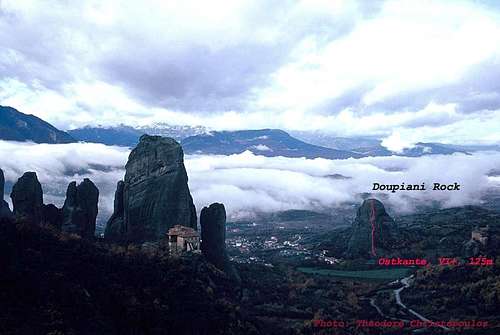
Ostkante (East Ridge) is one of the most popular routes in Meteora. It's located on the Doupiani Rock, which is for sure the most popular rock in Meteora. Although it's a relative "easy" route, it needs a serious approach, because of the kind of the climbing: slabby and runout. A fall is not an option for the leader in the first 3 pitches. First ascent: D. Hasse and H.L. Stutte on 17.8.1976.
Route report
Scramble unroped (I) about 12-15m, from the right side (easier) of the ridge, to the start of the route. There is a ring for belaying.
Pitch 1: Easy slab (max III) for 40m. There are 3 bolts. Belay on this ring
Pitch 2: Continue on the ridge on the same difficulty (III) for 25m - 2 bolts to the next belay ring.
Pitch 3: There are 2 options: Go left (III) for some meters and then up (V+) to the groove that leads left of the rock gendarm or go diagonally left (V) to the groove (variant). Both options has 2 bolts (the second bolt is the same). This pitch is 25m long. Belay on the ring on the big ledge with tree.
Pitch 4: Climb the face to the top. The face is almost vertical with small stones for holds. This pitch was first climbed on boots and aid (A1), but later was free at VI (Hasse-Stutte guidebook). Nowadays is a little harder (VI+, maybe VII-), because some crucial stones left from the face. It can be climbed on aid as well. The pitch is getting easier as you go higher. It's 35m, with 5 bolts. Belay on the ring, near the top.
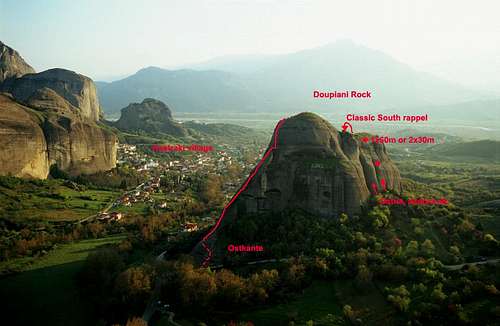
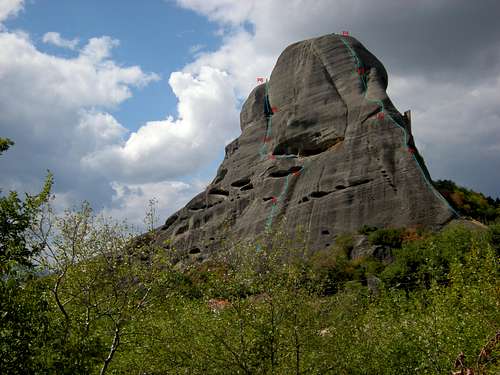
Descent: From the top (there is a summit book) you walk the obvious trail going W, downclimb an easy step(I), to the saddle, see this photo again. There are 2 options:
--Abseil the N-NW face of Doupiani. A small (8-10m) abseil to various rings and then one 60m to the bottom or 2x30m abseils. You can approach the rings from the right (a little exposed!). Don't abseil all the way down from the highest ring, a lot of friction on rope pulling because of low angle terrain. This side of Doupiani can be extremely crowded, so take care with loose rocks, ropes, etc.
--Abseil the S side. This is the classic descent of Doupiani. Find the ring on the top of the 'canyon' to the S. One 40m abseil, then walk (for 70m) the wide ridge on the left (as you see down), to a dead end, find a ring, another abseil (10m), then walk to the ground.
In both cases it's better to carry your shoes on the harness, or you have to walk 5-10 minutes on your climbing shoes...back to the base of the route.
Something very important for abseiling in Meteora is the way of putting the knot through the 'horizontal' rings. You have to put the rope with the knot (the rope for the pull) on the downside of the ring (between the ring and the rock). Otherwise maybe there is a problem, because the pulling rope is blocking the other rope, pressing it with the ring to the rock.
The time for the whole route with descent is about 1:30 to 3:00 for the most parties. The rock quality in Doupiani is the best in Meteora and Ostkante has hundreds (maybe thousands) of repeats, so has practically no loose rock. Even though, pay a little more attention after rain, when the rock gets softer.
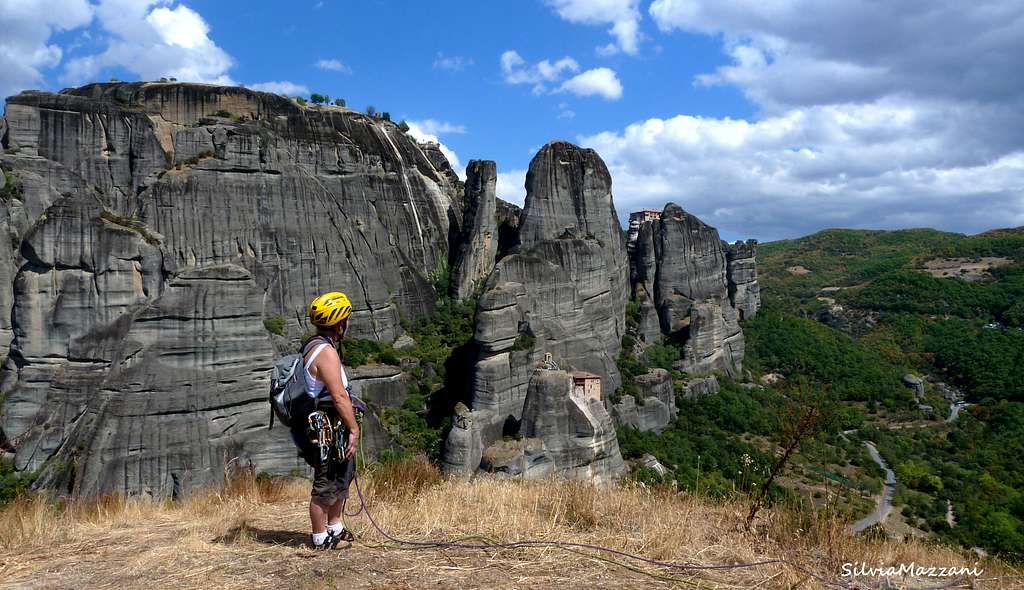
Ohne Vorbehalt report
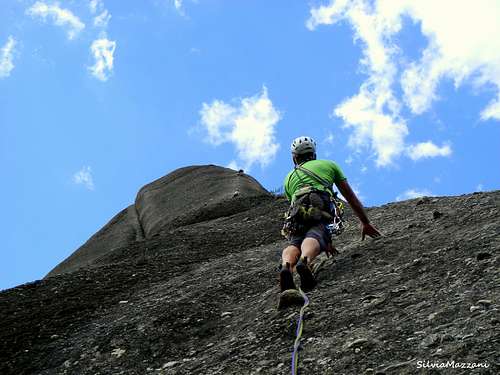
The route Ohne Vorbehalt is situated on the South-East wall of Doupiani. It's the first route on the left of the Ostkante (East Ridge). From the parking lot reach the base of the East Ridge and continue skirting the rocky slopes to get in few minutes the start of Ohne Vorbehalt.
Pitch 1: Climb up a sloping wall that progressively straightens up, IV+, 35 m
Pitch 2: Climb directly the wall which has now become steep, then obliquate to the left to a belay under an overhang, V-, 40 m
Pitch 3: Surround the overhang and overcome it on the left, then slanting left enter a groove of compact rock to be climbed with balanced moves up to the base of a vertical wall. Climb the wall with a few meters of beautiful climbing up to the belay, V+, 35 m
Pitch 4: Up the vertical wall with some very technical steps to the summit, VI-, 35 m
Descent: Abseil the same route
Other routes
- Sudweg
- Regenpfeiler
- Sudostwand
- Dickes Ende
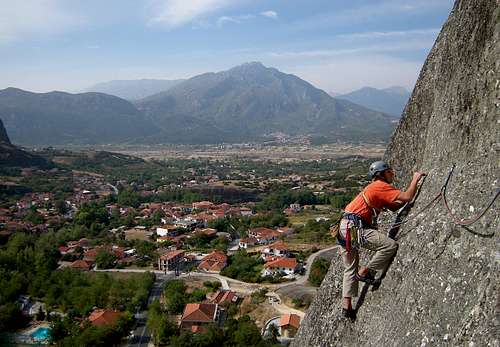

Essential Gear
For the routes on Doupianifels you need: 2x50m half/twin ropes, helmet, personal gear (harness, lockers, belay/rappel device, climbing shoes), slings and 7-8 quickdraws.
As a general rule on the Doupianifels - as in most of the Meteora routes - there is no opportunity to place additional protections in addition to the fixed bolts, so don't carry nuts/friends.
Red Tape and Ethics
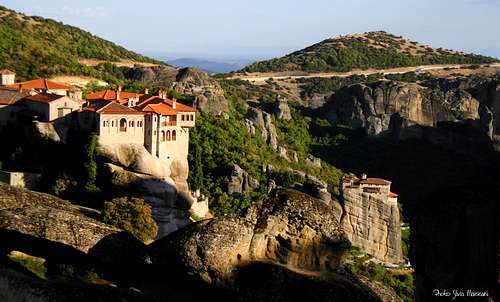
No fees and no permits required. Anyhow, if you are visiting this area, remember that the climb on the towers where the inhabited monasteries are located is prohibited. In the '70s Dietrich Hasse and his team decided, together with local authorities, not to climb any route on these latter summits. This rule applies even today, together with the suggestion that climbers have not to add fixed protections to the pre-existing ones. Since the year 1988 Meteora was declared a Meteora Unesco World Heritage Site.
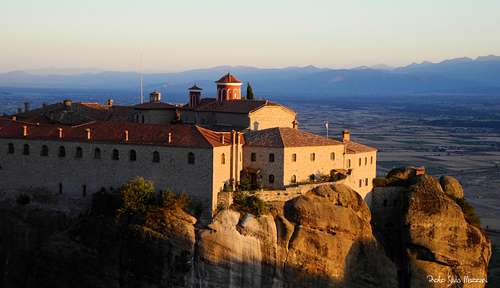
Geology and rock climbing
The rock is a gray-brown conglomerate. It is believed that the needles began to form in the Tertiary - about 60 million years ago - starting from the materials deposited at the border of the Thessaly plain when the prehistoric sea waters, which previously covered the plain, withdrew. Successively, slowly the conglomerates needle were sculpted over the millennia by water, wind and earthquakes. The texture of Meteora rock results from a mix of pebbles, cobbles and larger stones, packed into a rock surface which appears like concrete, but actually is a mixture of conglomerate and sandstone. Sometimes cobbles leaked from the rock to leave shallow holes in their place. What emerges is a peculiar climbing style, mainly slabby and balancy on cobbles, consisting in exploiting small or large pebbles protruding, or otherwise the holes remained where the same pebbles were formerly located. As soon as you get used to it, the climb will provide fun and generally little tiring.
Nature and climate
The vegetation is considered as supra-Mediterranean, with climax cover of Quercus and Ostrya species and Fagus sylvatica beech forest above 700 m. The area includes forested hills and river valley with forests of Platanus orientalis and species such as the endemic Centaurea lactifolia Centaurea kalambakensi. Meteora during the summer is influenced by the climate of the tropics extending its influence into the Mediterranean area and therefore a great heat can be expected, while during the winter the area is influenced by the Central Europe climate, that often produces changes from fair weather conditions to bad weather conditions. Best seasons are the middle ones: Spring till middle May and early Fall.
When to climb
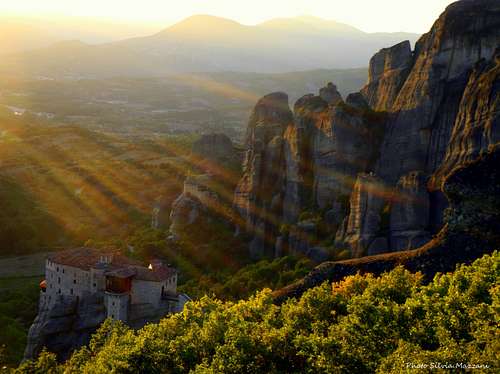
Spring and Autumn are the best seasons for Meteora. Avoid Summer, especially really hot days. Ostkante is a good choice for Winter mornings. The route has sun until noon (more or less, depending on the season). It's also a good choice after a rainy period because it's a ridge, sunny and East facing, this means that gets dry faster than most routes.
Accomodation
There are a great number of hotel rooms, B&Bs and rooms to rent in the village of Kastraki, the village built in the shadow of the Meteora towers. The nearby town of Kalabaka also features many accomodation choices. There are also three organized campsites, amongst which the nearest one to the crags is Camping Vrachos in Kastraki. There is also a smaller campsite near the tower of Doupiani. There are plenty of eating out options, particularly tasty traditional Greek food and pizzerias, both in Kastraki and Kalambaka.
Meteo
External links
Guidebooks and maps
|
Meteora
Heinz Lothar Stutte - Dietrich Hasse
Climbing and hiking guidebook I edition 1986 - German and English
The basic guidebook to climb and hike in Meteora
|
|
|
Meteora
Heinz Lothar Stutte - Dietrich Hasse
Climbing guidebook II edition 2000 - II edition not a complete guidebook, but an update to the I edition - German, Greek and English
ISBN3-922066-05-4
|
There are two useful guidebooks to consult:
“Meteora – Climbing and hiking” by Dietrich Hasse and Heinz Lothar Stutte - I edition 1986, in English and German. It contains around 230 routes. Also, it provides general information about mountaineering, hiking in Meteora, maps, directions.
“Meteora Climbing Part II” by the same Heinz Lothar Stutte and Dietrich Hasse – II edition 2000 – German, Greek and English - Note: the II edition is not a complete guidebook, but an update to the I edition
The Meteora guidebooks can be purchased in Kastraki, Taverna Paradisos or Camping Vrachos. There is also a useful map by the same authors that can be purchased in local shops in Kastraki.
